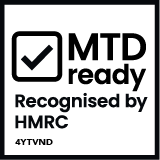Standard Rate VAT Scheme
On the Standard Rate VAT Scheme, you charge VAT on invoices (usually 20%) and pay this over to HMRC. You can reduce the amount you pay by claiming the VAT you pay on allowable expenses.
On this scheme, you have to keep track of the VAT you charge on your invoices, and also the VAT you pay on expenses.
If you earn over £85,000, you must register for VAT.
Learn more on gov.uk.










